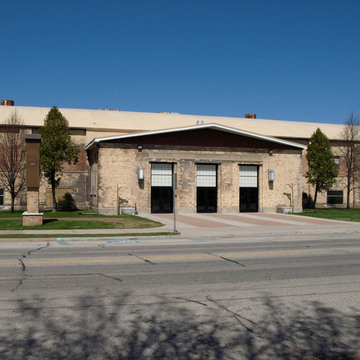You are here
Pullar Community Building (Pullar Stadium and Community Building)
After Sophia Nolte Pullar left $70,000 to the City of Sault Ste. Marie with which the city could start either a home for the elderly or a community center, her trustees selected the latter. They determined that a community center that doubled as an ice rink more closely met Pullar's intent. At the Sault, indeed, across Canada and the northern United States, figure skating, ice hockey, and recreational skating are popular pastimes.
The austere Moderne structure resembles those associated with federal government–sponsored buildings of the 1930s and 1940s. A shallow barrel roof covers the symmetrically arranged horizontal building, and a pedimented three-door entrance pavilion projects at the center. The walls are pale yellowish-brown brick. The arena floor lies directly on the ground without insulation. Only steel bars and chicken wire protect spectators from flying pucks. The building accommodates the ice skating rink with a pro and rental shop and concessions, parks and recreation offices, and the Manny Boucher Room for public meetings. Today the stadium is also used for events. A donation from the Cecelia M. Matheson Trust in 2010 will fund replacement of windows and improvements to dressing rooms and restrooms.
Writing Credits
If SAH Archipedia has been useful to you, please consider supporting it.
SAH Archipedia tells the story of the United States through its buildings, landscapes, and cities. This freely available resource empowers the public with authoritative knowledge that deepens their understanding and appreciation of the built environment. But the Society of Architectural Historians, which created SAH Archipedia with University of Virginia Press, needs your support to maintain the high-caliber research, writing, photography, cartography, editing, design, and programming that make SAH Archipedia a trusted online resource available to all who value the history of place, heritage tourism, and learning.









